Tkinter实现UI分页标签显示:
Input页,红色部分为当前Frame的位置,下半部分为第一页的子标签;三页标签的显示内容各不相同。实现分页显示的核心组件为Radiobutton,Radiobutton只有一个选项能够生效,使用参数indicatoron=0能够将Radiobutton显示为Button的形状,通过选定的Radiobutton将原有的Frame forget掉,同时,将预定的Frame pack,实现分页的效果。使用时要将更换的组件放入一个Frame中,定义一个函数进行选定Radiobutton的参数传递,实现切换。如果对Radiobutton使用bind的话,当前选定的Radiobutton只能在下次事件触发时生效,始终慢着一拍,所以使用command选项赋值标签切换函数。
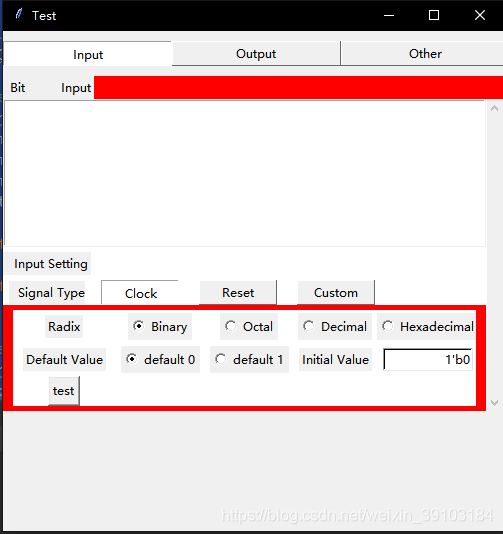
第二页Output
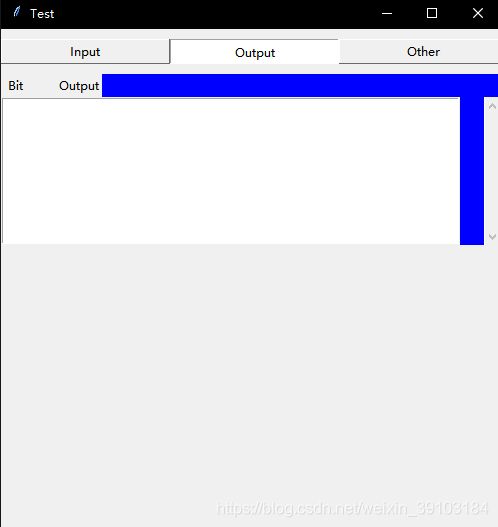
第三页Ohter
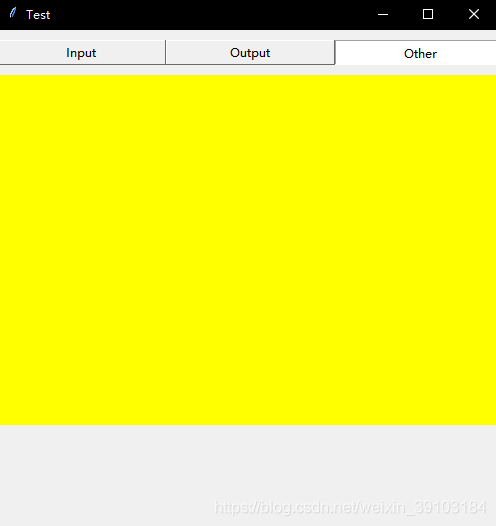
第一页的子标签,分为三部分,每页的内容独立
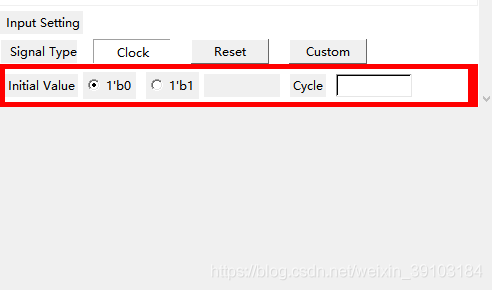
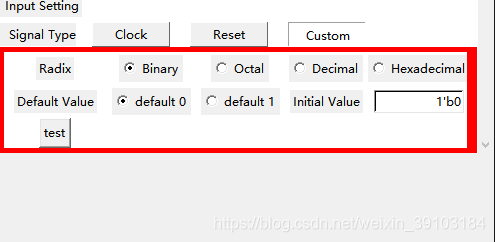
源码如下:
|
1
2
3
4
5
6
7
8
9
10
11
12
13
14
15
16
17
18
19
20
21
22
23
24
25
26
27
28
29
30
31
32
33
34
35
36
37
38
39
40
41
42
43
44
45
46
47
48
49
50
51
52
53
54
55
56
57
58
59
60
61
62
63
64
65
66
67
68
69
70
71
72
73
74
75
76
77
78
79
80
81
82
83
84
85
86
87
88
89
90
91
92
93
94
95
96
97
98
99
100
101
102
103
104
105
106
107
108
109
110
111
112
113
114
115
116
117
118
119
120
121
122
123
124
125
126
127
128
129
130
131
132
133
134
135
136
137
138
139
140
|
import tkinter as tkclass TestBenchMaker: def __init__(self): self.TITLE = "Test" self.WIDTH = 500 self.HEIGHT = 500 self.parseDic = {} # Initial GUI def initialGUI(self): # Change tag def changeTag(tag): frame3.pack_forget() frame4.pack_forget() frame5.pack_forget() if tag == 0: frame3.pack(fill=tk.X) elif tag == 1: frame4.pack(fill=tk.X) elif tag == 2: frame5.pack(fill=tk.X) # Change type def changeType(tag): clockSet.pack_forget() resetSet.pack_forget() customSet.pack_forget() if tag == 0: clockSet.pack(side=tk.TOP, fill=tk.BOTH, expand=tk.YES, pady=5, padx=10) elif tag == 1: resetSet.pack(side=tk.TOP, fill=tk.BOTH, expand=tk.YES, pady=5, padx=10) elif tag == 2: customSet.pack(side=tk.TOP, fill=tk.BOTH, expand=tk.YES, pady=5, padx=10) window = tk.Tk() window.title(self.TITLE) # Place GUI on the center of screen self.ws = window.winfo_screenwidth() self.hs = window.winfo_screenheight() x = (self.ws / 2) - (self.WIDTH / 2) y = (self.hs / 2) - (self.HEIGHT / 2) window.geometry('%dx%d+%d+%d' % (self.WIDTH, self.HEIGHT, x, y)) # Tag: 0 --> input; 1 --> output; 2 --> other frame2 = tk.Frame(window) frame2.pack(fill=tk.Y, pady=10) tag = tk.IntVar() tagWidth = 23 tk.Radiobutton(frame2, text="Input", command=lambda: changeTag(0), width=tagWidth, variable=tag, value=0, bd=1, indicatoron=0).grid(column=0, row=1) tk.Radiobutton(frame2, text="Output", command=lambda: changeTag(1), variable=tag, width=tagWidth, value=1, bd=1, indicatoron=0).grid(column=1, row=1) tk.Radiobutton(frame2, text="Other", command=lambda: changeTag(2), variable=tag, width=tagWidth, value=2, bd=1, indicatoron=0).grid(column=2, row=1) # frame3 --> Input # Signal info frame3 = tk.Frame(window, height=300, bg="red") frame3.pack(side=tk.TOP, fill=tk.X) tk.Label(frame3, text=" Bit Input").pack(side=tk.TOP, anchor=tk.W) scroll = tk.Scrollbar(frame3) scroll.pack(side=tk.RIGHT, fill=tk.Y) self.inputBox = tk.Listbox(frame3, bd=1, selectmode=tk.SINGLE, yscrollcommand=scroll.set, height=8) self.inputBox.pack(side=tk.TOP, anchor=tk.NW, fill=tk.X, expand=tk.YES) scroll.config(command=self.inputBox.yview) # Input setting width = 10 frameInputSet = tk.Frame(frame3, bg="white") frameInputSet.pack(side=tk.TOP, fill=tk.BOTH, expand=tk.YES) tk.Label(frameInputSet, text=" Input Setting").grid(row=0, column=0, pady=5) tk.Label(frameInputSet, text=" Signal Type", width=width).grid(row=1, column=0) # Tpye: 0 --> clock; 1 --> reset; 2 --> custom type = tk.IntVar() tk.Radiobutton(frameInputSet, text="Clock", variable=type, value=0, command=lambda:changeType(0), bd=1, indicatoron=0, width=width).grid(row=1, column=1, padx=10) tk.Radiobutton(frameInputSet, text="Reset", variable=type, value=1, command=lambda:changeType(1), bd=1, indicatoron=0, width=width).grid(row=1, column=2, padx=10) tk.Radiobutton(frameInputSet, text="Custom", variable=type, value=2, command=lambda:changeType(2), bd=1, indicatoron=0, width=width).grid(row=1, column=3, padx=10) # Clock setting initalValue = tk.StringVar() initalValue.set("1'b0") cycle = tk.StringVar() converse = tk.StringVar() clockSet = tk.Frame(frame3, bg="white") #clockSet.pack(side=tk.TOP, fill=tk.BOTH, expand=tk.YES, pady=5, padx=10) tk.Label(clockSet, text="Initial Value").grid(row=0, column=0, pady=5) tk.Radiobutton(clockSet, text="1'b0", variable=initalValue, value="1'b0").grid(row=0, column=1, padx=5) tk.Radiobutton(clockSet, text="1'b1", variable=initalValue, value="1'b1").grid(row=0, column=2, padx=5) tk.Label(clockSet, text="", width=10).grid(row=0, column=3) tk.Label(clockSet, text="Cycle").grid(row=0, column=4, pady=5, padx=10) tk.Entry(clockSet, textvariable=cycle, width=10, bd=2, bg="white").grid(row=0, column=5) # Reset setting resetSet = tk.Frame(frame3, bg="white") tk.Label(resetSet, text="Initial Value").grid(row=0, column=0, pady=5) tk.Radiobutton(resetSet, text="1'b0", variable=initalValue, value="1'b0").grid(row=0, column=1, padx=5) tk.Radiobutton(resetSet, text="1'b1", variable=initalValue, value="1'b1").grid(row=0, column=2, padx=5) tk.Label(resetSet, text="", width=10).grid(row=0, column=3) tk.Label(resetSet, text="Converse").grid(row=0, column=4, pady=5, padx=10) tk.Entry(resetSet, textvariable=converse, width=10, bd=2, bg="white").grid(row=0, column=5) # Custom setting defaultValue = tk.IntVar() radixValue = tk.IntVar() radixValue.set(0) customSet = tk.Frame(frame3, bg="white") customSet.pack(side=tk.TOP, fill=tk.BOTH, expand=tk.YES, pady=5, padx=10) # Radix 0 --> b, 1 --> o, 2 --> d, 3 --> h tk.Label(customSet, text="Radix").grid(row=0, column=0, pady=5, padx=1) tk.Radiobutton(customSet, text="Binary", variable=radixValue, value=0).grid(row=0, column=1) tk.Radiobutton(customSet, text="Octal", variable=radixValue, value=1).grid(row=0, column=2) tk.Radiobutton(customSet, text="Decimal", variable=radixValue, value=2).grid(row=0, column=3) tk.Radiobutton(customSet, text="Hexadecimal", variable=radixValue, value=3).grid(row=0, column=4) # Initial value tk.Label(customSet, text="Default Value").grid(row=1, column=0, pady=5, padx=10) tk.Radiobutton(customSet, text="default 0", variable=defaultValue, value=0).grid(row=1, column=1, padx=5) tk.Radiobutton(customSet, text="default 1", variable=defaultValue, value=1).grid(row=1, column=2, padx=5) tk.Label(customSet, text="Initial Value").grid(row=1, column=3, pady=5, padx=5) tk.Entry(customSet, textvariable=initalValue, width=12, bd=2, bg="white", justify=tk.RIGHT).grid(row=1, column=4) tk.Button(customSet, text="test", command=lambda :print(initalValue.get())).grid() # frame4 --> Output frame4 = tk.Frame(window, height=350, bg="blue") tk.Label(frame4, text=" Bit Output").pack(anchor=tk.NW) scroll2 = tk.Scrollbar(frame4) scroll2.pack(side=tk.RIGHT, fill=tk.Y) self.outputBox = tk.Listbox(frame4, bd=1, selectmode=tk.SINGLE, yscrollcommand=scroll2.set, height=8, width=65) self.outputBox.pack(side=tk.LEFT) scroll2.config(command=self.outputBox.yview) # frame5 --> Other frame5 = tk.Frame(window, height=350, bg="yellow") window.mainloop()if __name__ == "__main__": tbm = TestBenchMaker() tbm.initialGUI() |
到此这篇关于python中Tkinter实现分页标签的示例代码的文章就介绍到这了,更多相关python Tkinter分页标签内容请搜索服务器之家以前的文章或继续浏览下面的相关文章希望大家以后多多支持服务器之家!
原文链接:https://blog.csdn.net/weixin_39103184/article/details/89046897










